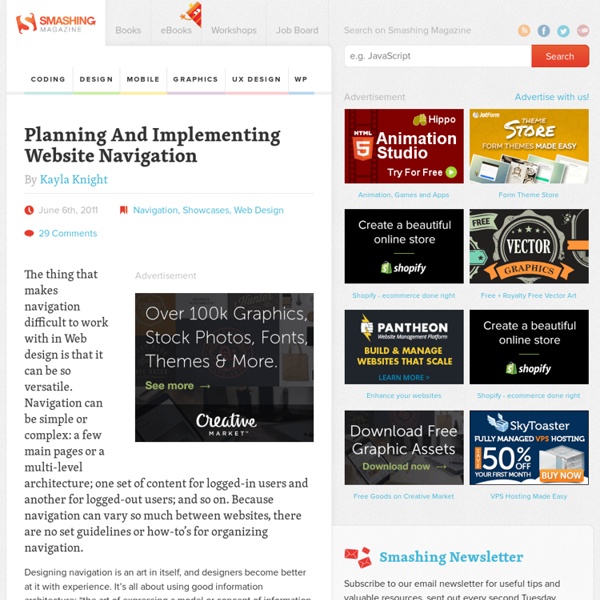Information design using card sorting
Written by James Robertson, published February 19th, 2001 Categorised under: articles, usability & information architecture At the beginning of any information design exercise, it is normal to be confronted by a very long list of potential subjects to include. The challenge is to organise this information in a way that is useful and meaningful for the users of the system. While careful investigation and analysis of the information may reveal some clues, it can be virtually impossible to determine which topics should be grouped together. The difficulty in organising the content stems from a lack of knowledge about how real users make use of this information. A card sorting session can go a long way towards resolving this problem. What is card sorting? In essence, card sorting works as follows: Write down each topic on a filing (index) card. This is a very simple, and often very effective, method of working with users to come up with a usable design. Why use this method? Involving the users
My (Simple) Workflow To Design And Develop A Portfolio Website
Card Sorting
Project Management (4) A project plan takes into account the approach the team will take and helps the team and stakeholders document decisions made regarding the objective, scope, schedule, resources, and... Creating an interdisciplinary team with the right mix of skills is vital to the smooth and successful execution of any project. Website requirements are a list of necessary functions, capabilities, or characteristics related to your website and the plans for creating it. User Research (14) When reporting results from a usability test, you should focus primarily on your findings and recommendations that are differentiated by levels of severity. Task analysis is the process of learning about ordinary users by observing them in action to understand in detail how they perform their tasks and achieve their intended goals. Usability Evaluation (14) Scenarios describe the stories and context behind why a specific user or user group comes to your site. Information Architecture (4)
Style Injection is for Winners
By "style injection", I mean being able to see styling changes immediately after authoring them without having to manually refresh your browser window. This isn't a brand new concept, I just mention it now because it's so awesome that if it's not a part of your workflow you should consider updating yours to include it. The Past For a long time, Dreamweaver had the ability to show you a live preview of what you were building. But they used some built-in WebKit thing to do it, running who knows exactly what version. No offense if you use and these editors or working this way, it's just not for me. New Style The first to come along that I knew of was LiveReload. The name "LiveReload" implies that it reloads the page for you, which is true when you change HTML or JavaScript. I'm a fan of CodeKit which has now also been doing this for a good while. If you're willing to put a script tag on your page, LiveReload works in Chrome, Safari, Firefox, Mobile Safari, and Opera (with finagling). Share On
Review Of Cross-Browser Testing Tools
10 Helpful Resources for Cross Browser Testing
Get the FlatPix UI Kit for only $7 - Learn More or Buy Now Every web designer knows that browser differences can create plenty of headaches. Finding and fixing problems can be difficult if you’re not equipped with the right tools. In this post we’ll take a brief look at 10 of the leading resources for making your browser testing less time consuming and more productive. Browsershots Browsershots is a popular free service that will provide screen shots of a page from just about any browser from all of the common operating systems. There is a paid option that will give you priority over the free requests. BrowserCam BrowserCam provides several different services for browser testing. BroswerCam is a paid service with options for daily, monthly, or yearly. NetMechanic Browser Photo Brower Photo from NetMechanic is a paid service that will allow you to test different versions of Internet Explorer, Opera, Firefox and Safari on Windows, Mac and Linux. Litmus IE NetRenderer BrowserCamp ieCapture iPhoney
How to Design Responsively
This guest post about responsive design comes from Krasimir Tsonev! Introduction In this article I want to share my thoughts regarding responsive design. I made several talks on this subject and this post is some kind of summary. What is responsive web design Scott Kellum said something which I think describes the responsive design perfectly: Responsive web design isn’t your site working on phones and tablets. Nowadays there are dozen of mobile devices, a lot of different resolutions and still several browsers. The tools Like every new thing, responsive design is not something that you can jump in for just a hour. In general there are three instruments which we can use to achieve responsiveness: Why we should care about the responsiveness I don't think that I have to convince you to make your site/application responsive. The main function of the Web is to deliver information to the users. So, who is responsible for all this responsive craziness .. the Mobile Web? Actually the answer is no.



